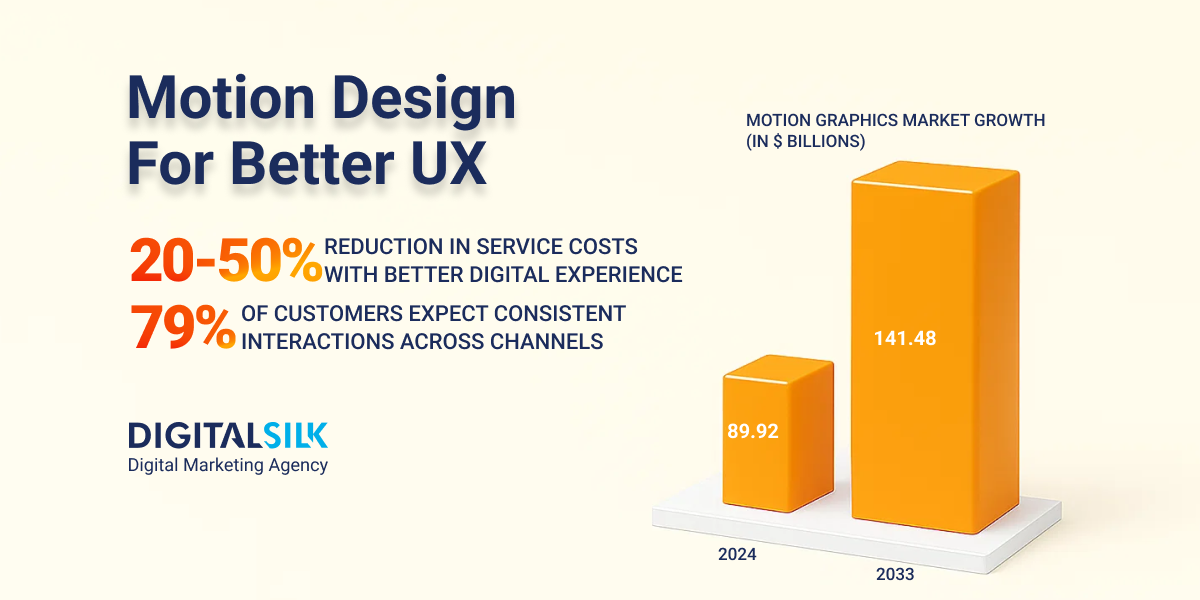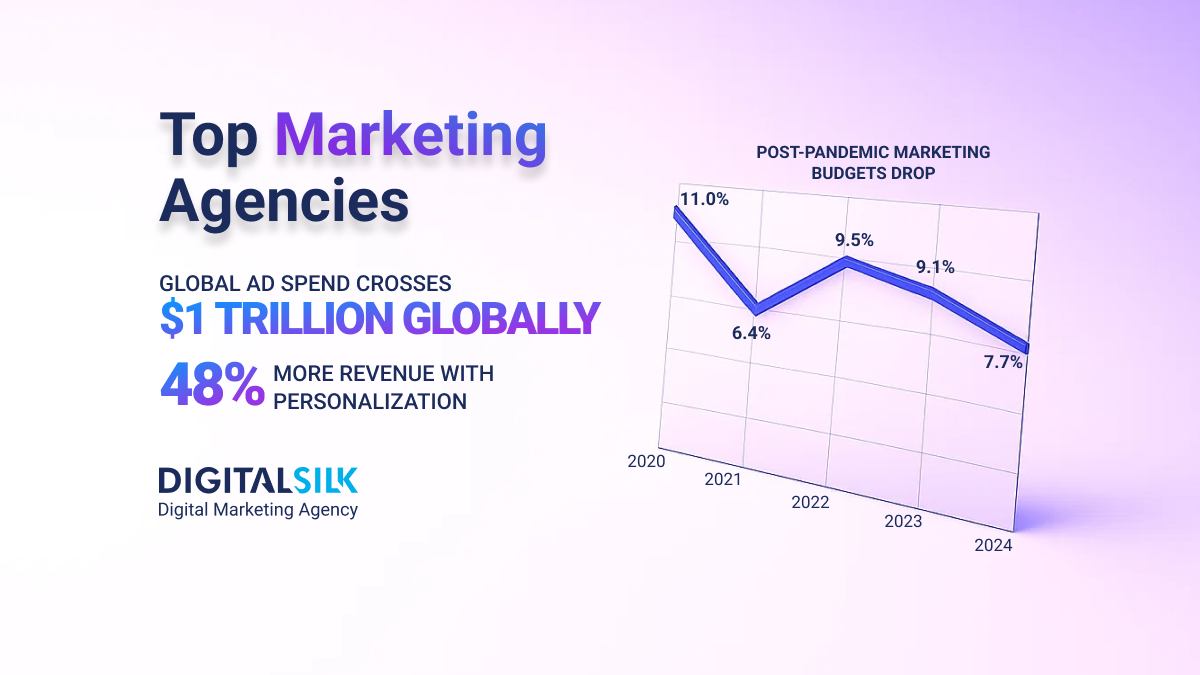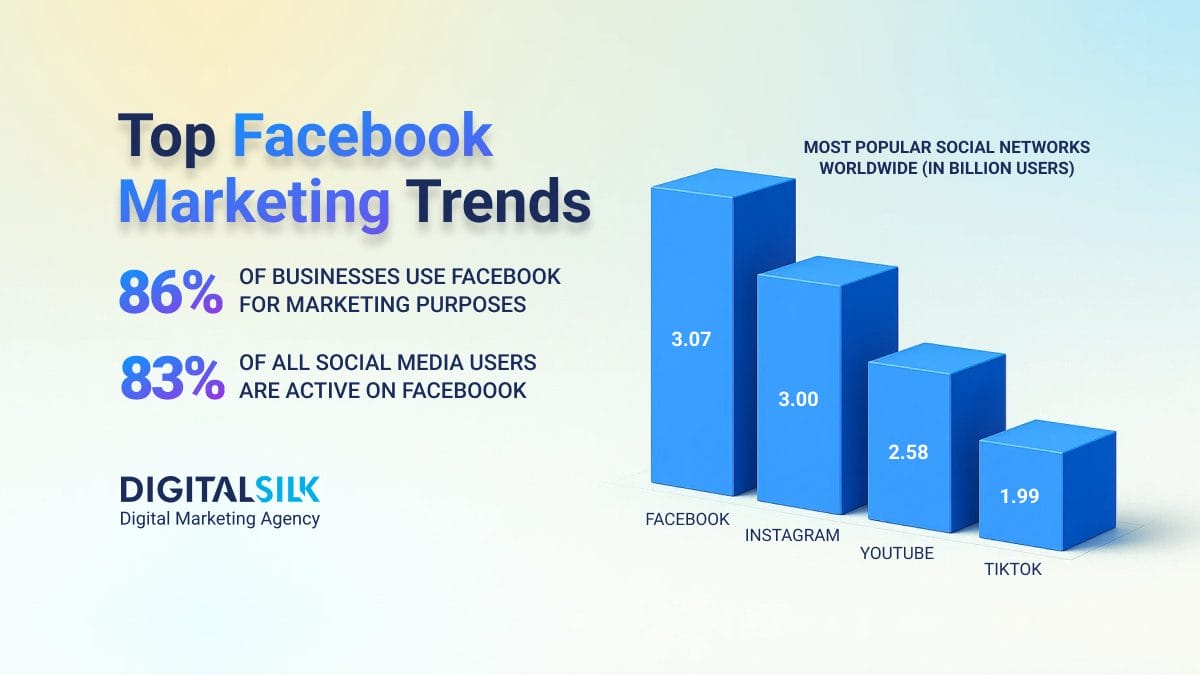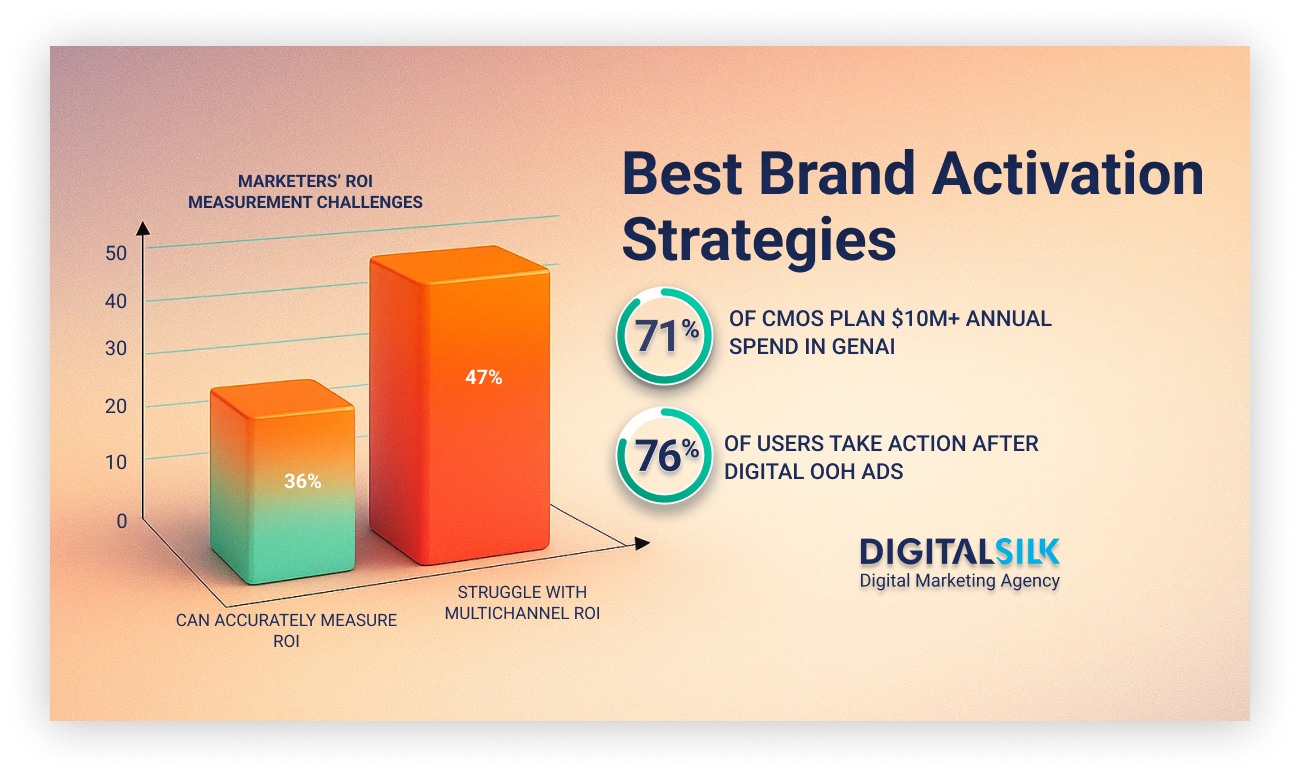Motion Design: Key Highlights
-
Motion defines modern usability: When every movement serves a clear purpose, users navigate intuitively, reducing hesitation and improving engagement across screens.
-
Consistency creates trust: Unified motion systems align design, development and brand expression, making every interaction feel reliable and cohesive.
-
Performance drives perception: Well-timed, responsive animations not only improve flow but also signal craftsmanship, elevating brand quality and user confidence.
Every pixel that moves should serve a purpose.
When done right, motion design makes digital experiences easier to use and harder to forget.
According to McKinsey, improving digital customer experience can lead to a 10 — 20% increase in customer satisfaction, a 10 — 15% rise in sales conversion and up to a 50% reduction in service costs.
That’s why modern brands now treat motion design as a strategic part of user experience (UX). It guides attention, builds trust and reinforces identity from app interfaces to enterprise websites.
Here are nine ways motion design enhances user experience, with examples from brands that use movement to inform, engage and convert.
9 Motion Design Rules For Smarter UX
Motion design is all about making movement meaningful.
It helps people feel guided and informed.
It gives every digital experience a sense of rhythm and responsiveness, where users intuitively understand what’s happening and why.
Used intentionally, motion becomes a design language of its own, one that builds trust, reinforces brand quality and keeps users engaged from the first tap to the final click.
The global motion graphics market, valued at $89.92 billion in 2024, is projected to reach $141.48 billion by 2033.
This growth shows how motion design has evolved from a creative enhancement into a strategic driver of engagement, storytelling and brand performance.
1. Guides Attention & Simplifies Navigation
People follow motion instinctively.
When movement directs focus, users spend less time figuring out what to do next. Even a small shift can have a measurable business impact.
According to the Nielsen Norman Group, purposeful animation helps users understand what has changed on screen, reducing cognitive load and improving orientation.
Each motion becomes a visual breadcrumb that reduces friction and helps users complete tasks faster.
Airbnb’s interface uses vertical expansion and smooth transitions to keep users oriented through the booking flow.
Each field, from destination to date selection, expands fluidly into view, guiding attention naturally and creating a sense of continuous movement instead of fragmented screens.
How To Apply
- Audit every moment where users shift focus, e.g., expanding forms, scrolling lists or switching between content sections.
- Add smooth, vertical or contextual motion (150 — 250 ms) that shows where new information appears and how it relates to the previous state.
- This reinforces spatial awareness and keeps the flow intuitive without slowing interaction.
2. Builds Emotional Connection
Motion gives a product its rhythm and personality. The way screens expand, collapse or fade shapes how people feel while using it.
According to Google’s Material Design motion guidelines, motion should preserve continuity, help users understand where changes originate and reflect the product’s character through consistent pacing and direction.
In other words, animation is meaningful when it supports how the product behaves, not when it distracts.
Apple integrates motion into product storytelling.
On its site, imagery flows smoothly, transitions align with user scroll and each reveal feels deliberate.
The pacing mirrors Apple’s brand personality, which is calm precision, creating a sense of quality and trust before a single feature is read.
How To Apply
- Define how your product should feel in motion, e.g., energetic, composed, playful or elegant and apply that behavior consistently.
- Use motion to communicate continuity between states and to express your brand’s tone.
- When every movement aligns with your product’s personality, the experience feels cohesive and human.
3. Reinforces Brand Identity Through Consistency
Consistency across channels is credibility.
When every transition, micro-interaction and feedback cue behaves predictably, users feel supported without having to think about what comes next.
79% of customers expect consistent interactions across departments and touchpoints, yet most say they rarely experience it.
Familiarity, and not novelty, is what builds the trust that keeps users loyal.
For example, Slack uses uniform motion for every interaction.
Loading states, side panels and notifications all move with the same timing and easing.
The experience feels cohesive, human and predictable, and users associate these traits with quality.
How To Apply
- Create a motion section in your design system.
- Define standard durations, easing curves and permitted transitions for each use case. Apply them everywhere.
- A unified motion language communicates design discipline and reinforces brand identity at scale.
4. Provides Instant Feedback & Builds Confidence
Users expect acknowledgment when they act.
A button that compresses slightly or a card that animates into a success state reassures them that the system is responsive.
Research shows that interfaces with micro-animations are perceived as more trustworthy and higher quality than identical sites without animations, strengthening user confidence and supporting smoother workflows.
Interfaces that respond clearly and quickly make your brand feel competent, and this perception improves retention and conversion alike.
Spotify uses micro-interactions to give feedback for user actions.
For instance, when a user “likes” a track, the plus animates into a green check mark to confirm the item has been saved and a short message “Added to Liked Songs” appears at the bottom of the screen.
According to Spotify Design, this motion-driven feedback increased user interaction with the like button and improved content recommendation metrics.
The motion is quick and fluid, reinforcing feedback through both animation and text. This subtle interaction makes the save action feel instant and rewarding.
How To Apply
- Add instant, lightweight motion to all primary interactions.
- Keep feedback animations under 400 ms so they feel fast and natural.
- Avoid overdesigning. Your goal is to confirm success, not entertain.
5. Makes Transitions Seamless
Moving from one view to another should feel like turning a page, not switching tabs.
Good transition motion preserves context. It shows users where they came from and where they’re going, reducing the mental effort of re-orienting.
Gartner found that 62% of customer service channel transitions are ‘high-effort’ for the customer.
Smooth motion design works the same way, i.e., it preserves context without leaving the user to guess.
Google Maps handles transitions flawlessly.
When you switch from a search list to the live map, the camera pans smoothly and zooms to the selected location rather than cutting abruptly.
That fluid transition helps users understand spatial relationships instantly.
How To Apply
- Use motion to preserve one shared element between views, for example, an image, title or card that morphs into its new state.
- Keep the movement fast (200 — 300 ms) and directional to reflect hierarchy: downward for drill-downs, sideways for peers.
- The goal is orientation, not spectacle.
6. Turns Waiting Into Engagement
Users dislike waiting, but they hate uncertainty more.
When motion communicates visible progress, that uncertainty disappears and the wait feels shorter, even when the system isn’t actually faster.
Remember that how progress is shown matters as much as how fast it actually is.
Spotify Wrapped 2024 transforms loading into storytelling.
While the app generates listening data, animated transitions guide users through each reveal in rhythm with music playback.
The experience turns anticipation into engagement, and users stay focused because they can see movement, progress and intent behind every transition.
The wait becomes part of the experience, not a disruption.
How To Apply
- Animate meaningful progress during any delay longer than 600 ms.
- Use skeleton screens or animated loaders that imply continuity.
- Avoid loops with no end state and always communicate advancement. A moving experience feels faster, even when it isn’t.
7. Makes Complex Information Easy To Grasp
Motion can simplify what text alone cannot. It turns abstract ideas into experiences the eye can follow.
When processes, hierarchies or data relationships are shown in motion, users don’t have to interpret. Instead, they simply see how things work.
Visualizing change this way reduces mental effort, speeds understanding and helps people trust what they’re seeing.
IBM uses motion in its watsonx platform visuals, like animated UI sequences, to illustrate how data moves, transforms and yields insight.
That turns a complex AI pipeline into something users can see rather than read about.
How To Apply
- Convert dense explanations into short motion sequences.
- Show cause and effect rather than every step.
- Keep visual pacing slow enough to process, but concise enough to hold attention. Motion should clarify logic, not perform.
8. Strengthens Accessibility When Used Responsibly
Motion improves clarity when it’s informative, but it can hinder users who are motion-sensitive.
According to Google’s Material Design Motion Guidelines, movement should support understanding by indicating change or spatial relationships, not act as constant decoration.
The difference is intent. Motion should help users orient, not overwhelm them.
For instance, Microsoft Windows 11 lets users disable animation effects to reduce motion sensitivity, while keeping focus cues and state changes intact.
These controls show how accessibility and design can coexist.
Motion remains meaningful for most users, while those sensitive to movement can still navigate comfortably.
How To Apply
- Respect the prefers-reduced-motion preference in CSS and app settings.
- Replace non-essential animations with static feedback for motion-sensitive users.
- Always test with motion disabled to confirm functionality remains intact.
9. Signals Product Quality & Brand Competence
Users interpret seamless motion as proof of engineering precision.
Smoothness reads as stability, and stability builds trust.
When transitions feel intentional and consistent, they elevate how users perceive the entire brand, even for those who don’t consciously notice the design.
Samsung’s One UI 7 demonstrates this clearly.
Every panel slides, fades and scales with precision.
Motion follows natural physics, quick where interaction demands it, slow where clarity matters.
That uniform pacing and balance make the interface feel sophisticated and reliable, reinforcing Samsung’s image as a brand that values both performance and polish.
How To Apply
- Audit all high-visibility moments, such as hero banners, modals, page transitions. Remove abrupt jumps or mismatched easing curves.
- Use real-world physics: ease-in for exits, ease-out for entries.
- Treat motion like material: when it behaves with purpose, it signals quality.
Why Motion Design Matters For Businesses
Every movement on screen carries business value.
When motion is clear, purposeful and timed with intent, it guides users effortlessly, reduces friction and builds trust through perceived quality and control.
For today’s brands, motion design is a language that improves understanding and flow across digital experiences.
It helps users:
- See what’s happening in real time instead of guessing
- Stay oriented as they move between screens or steps
- Feel progress and responsiveness, reducing frustration and uncertainty
For enterprises, that translates directly into performance:
- Higher engagement and conversion rates as users find what they need faster
- Fewer support tickets because the interface communicates clearly through motion
- Increased brand perception — smooth transitions and natural pacing signal technical excellence and attention to detail
When implemented well, motion design turns interfaces into experiences that feel effortless and trustworthy.
It becomes a subtle but powerful driver of ROI, proving that design done right both looks and performs better.
Measuring The Impact Of Motion Design
Even subtle animation can move real business metrics.
When motion improves clarity and flow, users move faster, stay longer and feel more confident interacting with your product.
To measure its impact, look at both behavioral data and user perception before and after implementing motion.
Behavioral metrics to track:
- Task-completion time: Are users finishing key actions faster?
- Drop-offs between screens or steps: Do smoother transitions keep people from leaving mid-flow?
- Scroll depth and dwell time: Are visitors exploring deeper and staying more engaged?
- Interaction frequency: Are micro-animations prompting more clicks, taps, or hovers?
User-perception indicators:
- Ease of use or satisfaction: Do surveys and post-session polls reflect a smoother, more intuitive experience?
- Usability testing feedback: Do participants describe the flow as more natural or easier to follow?
- Session replays and heatmaps: Are users following motion cues without hesitation or confusion?
You can validate these insights with simple A/B tests, comparing flows with and without animation or by reviewing analytics dashboards that connect motion-driven moments with engagement or conversion.
Tools like Hotjar, FullStory and Contentsquare can reveal how users respond to motion in real time.
When motion enhances clarity and rhythm, you’ll usually see these numbers improve, often faster than with a full visual redesign.
A single, well-timed transition can shorten learning curves, reduce hesitation and make a product feelmore premium.
Motion that performs is motion that pays off, not just visually, but measurably.
Motion Design Trends For 2026 & Beyond
Motion design is shifting from a visual enhancement to a core part of user experience.
The next few years will see movement play a larger role in how brands communicate clarity, emotion and trust:
- AI-driven tools now help designers create transitions that adapt to user behavior in real time, reducing repetitive work while improving flow. This aligns with rising expectations around relevance, since 71% of consumers now expect personalized digital interactions.
- 3D and web-based motion graphics are adding cinematic depth to company websites without slowing performance. Adobe’s 2024 Creative Trends report highlights how 2D and 3D motion are converging across digital products, making interfaces feel more cinematic while remaining functional.
- Data-responsive motion sequences use analytics to personalize interactions, showing different animations based on user intent or stage in the journey.
- Sustainability is also influencing design choices. The Shift Project notes that richer digital experiences contribute to growing energy demand, pushing teams to rethink heavy visuals and transition complexity. Lighter, smarter animations that reduce energy use and load times are becoming a new standard.
Forward-thinking teams are already blending these trends, including AI-supported workflows, intentional depth, accessible visual cues and more sustainable motion patterns to deliver experiences that feel modern, intuitive and cohesive.
For brands, it’s all about using motion with precision so every transition, cue and reveal contributes to a smoother, clearer user experience without needing a full redesign every year.
Scaling Motion Design For Enterprise UX
For enterprise brands, motion design is about building systems that scale.
Each transition, gesture and easing curve should follow clear rules, ensuring consistency across teams, platforms and regions.
The chart below outlines key focus areas that help you maintain cohesion, efficiency and brand integrity as motion systems evolve.
| Focus Area | What It Means For Enterprise UX | Why It Matters |
| Design Systems | Establish clear motion standards inside your design system, such as timing, physics and interaction tokens. | Keeps brand motion consistent as digital products grow and evolve. |
| Cross-Team Alignment | Centralize key motion assets so multiple teams can reuse and adapt them across web, app and product interfaces. | Reduces design debt and speeds up production while maintaining cohesion. |
| Performance Optimization | Balance animation complexity with load times and responsiveness. Test motion performance on different devices. | Ensures motion enhances clarity without slowing the experience. |
| Governance & Scalability | Document approved patterns and easing rules for enterprise use. | Prevents fragmented brand expression and maintains trust across global markets. |
| Creative Expression | Combine usability with refined motion aesthetics, like elegant, restrained and purposeful. | Communicates quality and reinforces brand sophistication. |
When implemented at scale, motion design becomes a shared language across the brand, one that signals quality, guides users and unifies every digital experience.
Create Engaging Motion Design Experiences With Digital Silk
Motion design has become more than an aesthetic choice. It’s a tool that shapes how users think, feel and interact with your brand.
When movement aligns with purpose, it builds clarity, confidence and connection across all channels.
As a leading digital marketing agency, Digital Silk helps brands translate complex ideas into elegant, intuitive motion.
Our team combines creative storytelling with data-driven insight to craft experiences that move seamlessly, both visually and emotionally.
As a professional digital marketing agency, we offer:
- Custom motion graphics design services
- UX motion design and animation
- Complete branding services
- Custom web development and app creation
Contact our team, call us at (800) 206-9413 or fill in the Request a Quote form below to schedule a consultation.
"*" indicates required fields









